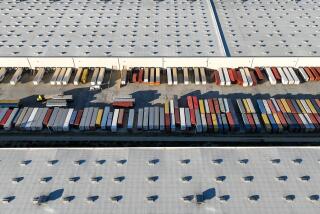City of Industry and County Settle Suit Over Pastureland Redevelopment
Los Angeles County has settled a lawsuit it filed in 1988 to keep the City of Industry from declaring 600 acres of city-owned pastureland a blight on the community and including it in a redevelopment zone.
The county--and three other plaintiffs in two lawsuits--contended last year that Industry was twisting state redevelopment law in an attempt to get up to $400 million in property tax from businesses to be built on the land. The revenue otherwise would go to the county, local schools and a dozen small, special-service districts.
But the Board of Supervisors agreed last week not to challenge the inclusion of the grassy hillside in a renewal zone if the city will forward to the county its full 57% share of property tax on new development. Usually, tax on new construction in a zone goes to the city redevelopment agency.
The city also agreed to pay an additional $1.1 million a year to the county for fire protection services and to spend $500,000 to remove freeway signs that violate a new county law. It also agreed to build or improve several roadways needed for the 600-acre project.
‘Good Deal’
“Fiscally, I think it’s a good deal,” said Deputy County Counsel Manuel Valenzuela.
Industry has also come to terms in recent months with two school districts and a community college, which would also benefit from the industrial parks the city hopes to lure to the 600 acres just north of the intersection of the Pomona and Orange freeways. The city projects about 7.2 million square feet of new construction over 35 years.
Under the agreements, the Walnut Unified School District and Mt. San Antonio Community College in Walnut would receive a small percentage of the property tax revenue generated by the project, while the Pomona Unified School District would get $1.2 million over the next two years.
Still blocking the city’s ambitious plan, however, is a lawsuit filed by an association of local businessmen, a regional group of redevelopment watchdogs and county taxpayer Susan Berg.
The watchdog group says establishment of the new zone is an illegal tax grab that will undermine legitimate redevelopment efforts in depressed areas by drawing development away from them.
The local business owners say that the cost of issuing bonds to pay for streets, sewers, roads and lighting in the new industrial park will keep the city from reducing its past bond debt, which they support through property taxes.
“We’re not willing to settle because the proposed project remains a massive abuse of the redevelopment process,” said Murray Kane, attorney for Berg, the Industry Civic Planning Assn. and Concerned Redevelopment Officials of Southern California.
Kane, also counsel for the Los Angeles Community Redevelopment Agency, said that state redevelopment law was passed 35 years ago to help aging cities rebuild slum areas, not to provide financing for prosperous cities such as Industry.
Most of Industry, a 14-mile-long business strip with only 700 residents, was vacant land when included in city redevelopment areas in the 1970s. About 80% of the city is within three such areas.
Blighted Areas
In an effort to close the loophole that allowed undeveloped land in the zones, the Legislature in 1984 tightened the legal definition of a project area, generally requiring that new zones be 80% urban and “blighted.”
But in an interview Tuesday, Industry City Atty. Graham A. Ritchie said the new zone is exempt from the 80% urban requirement because it is publicly owned.
The term blight has not been precisely defined in law. But state law does say a blighted area must be a “serious, physical, social or economic burden on the community which cannot reasonably be expected to be reversed or alleviated by private industry acting alone.”
The city argues that the 600 acres is an economic blight on it because the redevelopment agency has built up debts of $40.3 million in buying it in 1983 and financing it since then. That debt plus the cost of building roads and sewers and removing toxic wastes create overhead costs so high private industry cannot afford to build there without redevelopment agency assistance, Ritchie said.
One home builder did approach the city about putting a subdivision on the hillside, but the city did not pursue the matter because the land is zoned for industry, Ritchie said.
Even after settlements with the county and the three school districts, Industry expects to receive about 25% of the $400 million in taxes generated by the new project, he said.
More to Read
Sign up for Essential California
The most important California stories and recommendations in your inbox every morning.
You may occasionally receive promotional content from the Los Angeles Times.









